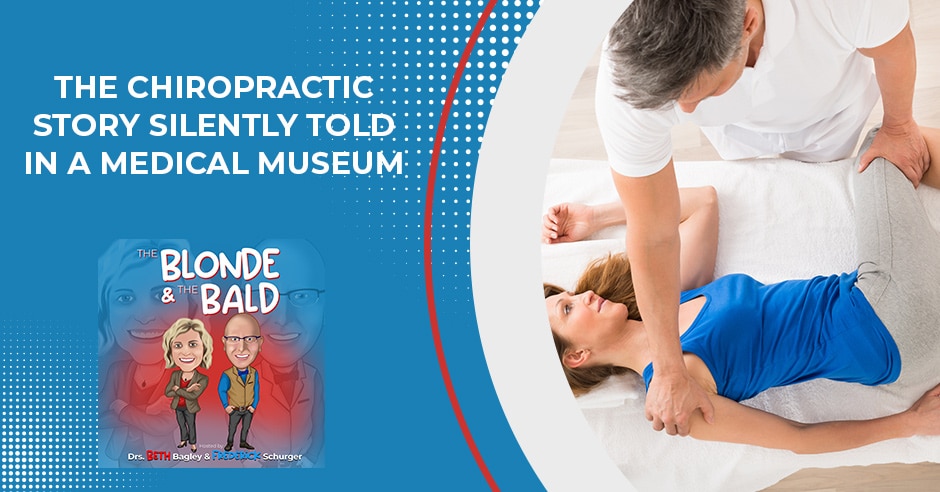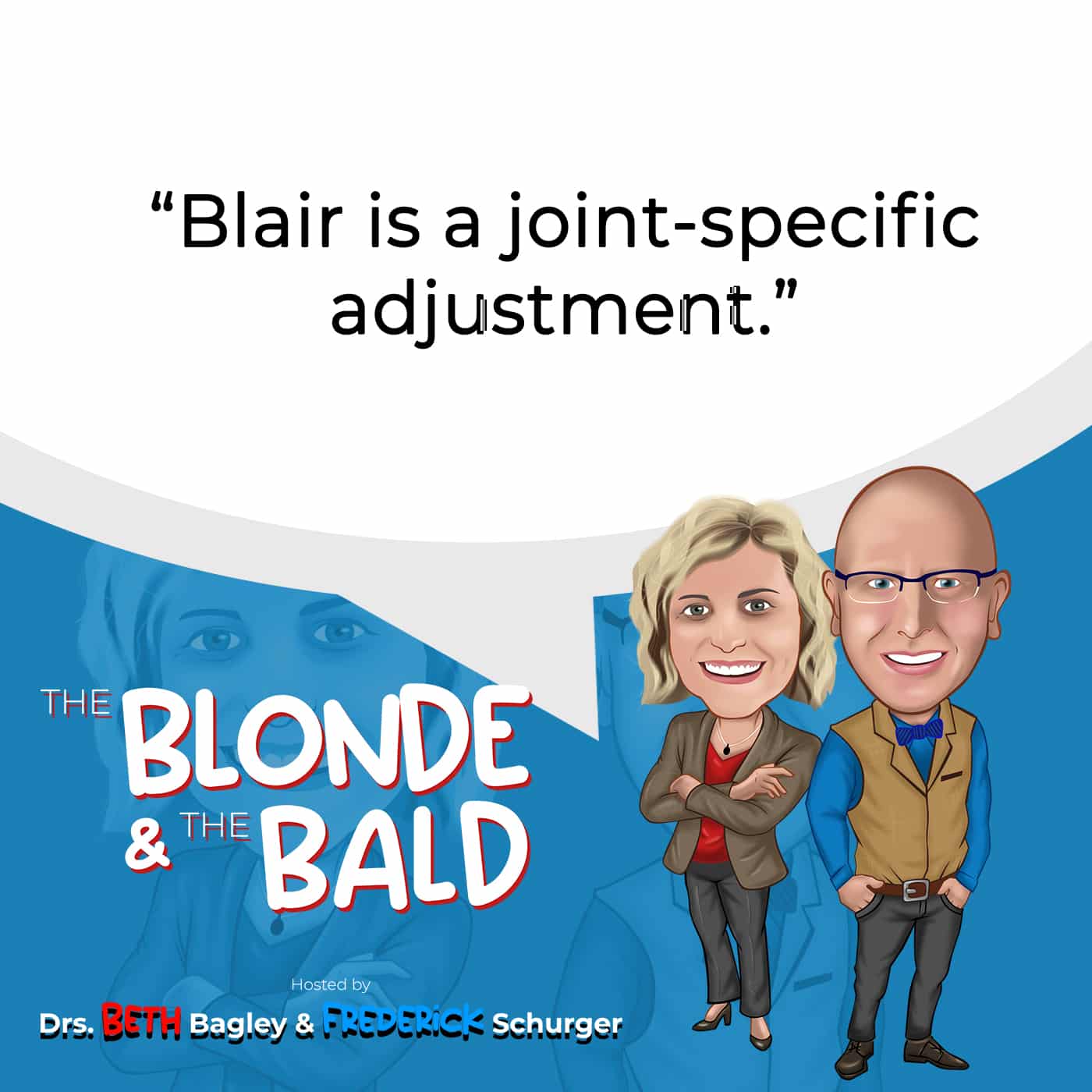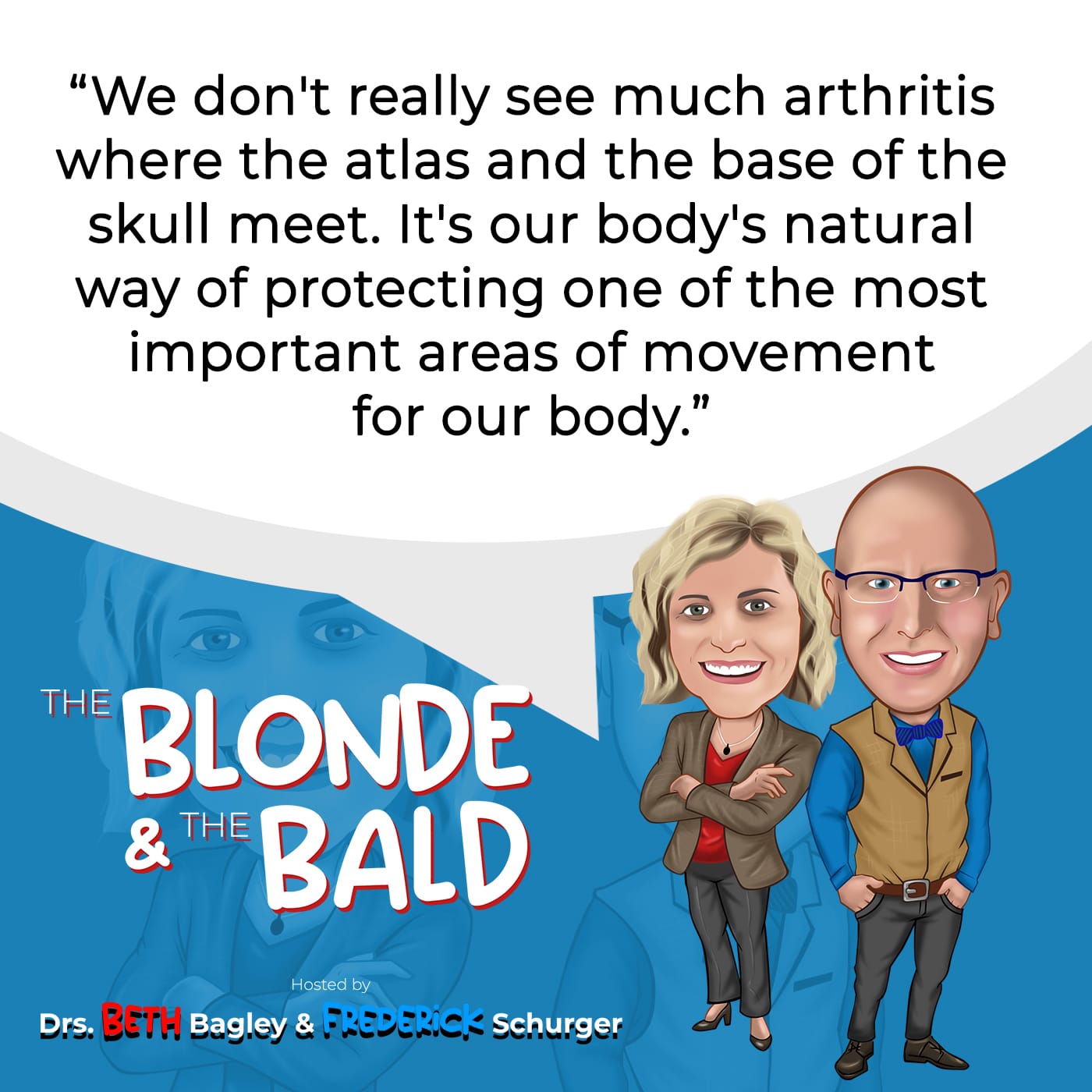
It’s easy to break something when there’s a misalignment in your structure. Our body is designed with certain fragility, and misalignment in our body can greatly affect our health. Dr. William Blair happened upon a case of a man in a medical museum who showcased proof of his theory of how bones get stuck out of place in one’s neck. Join us as we tell the chiropractic story silently told in a medical museum.
—
Watch the episode here
Listen to the podcast here
The Chiropractic Story Silently Told In A Medical Museum
Dr. Bagley, how are you?
I’m great. Dr. Frederick Schurger, it is so good to see you. We get to see each other in real life.
I’m looking forward to it because I am desperately in need of an adjustment. I woke up and my right knee said, “Your hip doesn’t work that way.”
The biomechanics of the body isn’t working right and your body is telling you.
My bite hasn’t been right.
I’ll punch you in the face. How about that?
I’m going to pass. I’ll let you adjust me but let’s not do the punch in the face. I haven’t earned that one yet.
We will see about it during this episode. We got some fun stuff to talk about. What do you have?
I had to remind my patients that I’m good but I’m not walk–on–water good.
You are not Jesus Christ.
I used to have long hair and a beard. Quite honestly, I can’t walk on water but we can put heads back on straight. I had one young gentleman here in who’s like, “I feel great.” He’s able to be more functional and get around a whole lot better. He looks a ton better than he was when he started. I had another patient who has been under some of the best chiropractors in the Central Illinois area. He was in.
I got his first Blair adjustment. He’s like, “That’s interesting.” He’s going to do great. He was back and forth. He’s been to osteopaths and they have done all the measurements to see if he’s got a short leg. I’m like, “It’s probably functional.” Sure enough, I adjust him. His legs balance out. His hip is going to relax and he’s going to feel tons better. We will see how it goes. You mentioned that you had two that you had to remind them of.
Honestly, it’s not interesting. It’s fortuitous that you bring that up. It’s kismet. I made sure to explain to two patients I’m not there to fix them. I don’t even fix neck pain. People are like, “You’re adjusting my neck.” I know I’m adjusting your neck but what we’re doing is replacing something misaligned. The healing doesn’t come from these hands. These are not magic. The healing comes from within.
We are innately wonderfully healing beings. We have been given this incredible power to heal but when there’s a misalignment of the spine, bad diet, or toxins in our environment, our ability to heal from things doesn’t quite work like it’s supposed to anymore. Our job as chiropractors is to remind you about the other stuff and move things out of the position that is causing that interference.
It’s about getting back to and restoring that natural ability for the body to function the way it’s supposed to because if you don’t have it, it’s not going to work the way it’s supposed to. We were talking about weird little pins and things like that because the body heals itself. If it’s got something that’s not working the way it’s supposed to, it can lay down a new bone and fix it.
This cool little pin is one of my first souvenirs in my engineering time. It’s one of those things. I was a field engineer. I would go from location to location all over the country. My first job was manufacturing TVs, not the cool flat screens but full–picture tubes. These things were heavy and hot because they were glass. They were created. This was not a glass piece but this was on that first project with me playing with robots.
We had three lines. I was in charge of the robots on the hot end as we called it. Those three lines had multiple robots. They had two lines up in production. The one line, I wasn’t worried about. The second line and the third line were identical lines to each other. The second line was in production. The third line hadn’t come online yet. In the second line, they’re fine–tuning all the stuff to make sure that everything is good so the same crew can move over to the new line when all of a sudden, my robot is picking up the flat front part of 27-inch TVs. Those were big TVs back in the day.
To put this in perspective, you have a piece of glass that weighs approximately 60 to 70 pounds that is still sitting at around 200 degrees centigrade. For those of you who can’t figure out what centigrade is to Fahrenheit and that level, don’t worry. It’s hot. You have to wear Kevlar gloves. These were thick and padded, not like what you have to get your dinner out of the oven. These were heavy–duty.
I was wearing guards up my arm on top of that when things would go down because you had to get it off this Kevlar belt. Otherwise, it would burn. If it’s on there for a little bit, it works fine. If it sticks too long, it’s a problem. My robot is supposed to pick it up with this huge vacuum line. All of a sudden, it drops a piece. It’s trying to pick stuff up but it doesn’t have a vacuum. I can’t figure out what happened.
Somewhere in this armature, my pin broke. I don’t have a replacement pin. I figured out a replacement pin for it. Everything goes back to normal. I get it fixed. I have a moment to pause and think, “Why did this break?” I go to the third line that has not gone into production and look into this box that has this pin in it. This is the pin that they had run back and forth at FANUC Robotics where I used to work for quality control.
Can you have this armature go back and forth so many times? That’s what they were doing. You have a pneumatic cylinder that is attached to this with another armature attached here. That’s why this should be one continuous piece. You can still see where it’s silver here and then it’s tarnished here. There’s a little bit of oxidation and then again silver. This was all in one piece uniform all the way across.
That middle section was not supposed to be there.
This is not supposed to be a mini–barbell or a dumbbell.
That’s why it broke.
The other one that went into production had worn away at this part. This is what we call in engineering a wear part. It is supposed to fail. This part here should fail first before something else in your system fails. That costs a lot of money. I replaced this part with a $2 bolt. I should say it was probably a $0.50 bolt that we cut. We quickly drilled this hole, put a pin through it, and put it in there. It was good to go and run again. This piece is designed to fail.
If something is going to fail you, you want a cheap piece to fail, not an expensive piece. The problem was we didn’t have flow controls on the air cylinder that was driving it. My home base building and the amount of air they had on this was set in such a fashion that it was not going to cause this level of damage. It was probably going to cause this level of damage.
It’s like a color change but not to wear off.
It’s not like this. The problem was it didn’t have flow controls. It didn’t regulate the pressure that was hitting here. It didn’t need a high pressure but unfortunately, when we ran it, it had a high pressure. Eventually, the pin failed sooner than it was supposed to. Generally, it should not have failed for several years as opposed to several weeks into production.
The reason I like to bring this up in a chiropractic sense is our bodies have things that have the potential to wear. They have the potential to repair. If this was a bone, this would have been repaired back to where it’s supposed to be but anytime you have improper pressures and improper forces placed on any part of the body, it is going to wear irregularly. That’s what we have here. This irregular wear starts to cause other problems. For instance, I woke up and the sleep was weird. I remember something popping in the middle of the night. My bite was off. My hip now feels off. If I left that unchecked and if I wasn’t getting checked, I might start having severe problems with my knee, not next week. My body might adapt to it.
The pain might even go away.
My body would adapt to that situation because I can adapt, whereas structures that don’t have living tissue can’t. I could have adapted and maybe I’ll be like, “I’ll be fine.” It might take 3, 5, 10, or 20 years before my knee fails, and then I have to get a replacement knee made of something like this. The problem is this is still harder than bone. When you start having this problem when you have a knee replacement, oftentimes, you will meet people who have not had one knee. They have had both knees and a hip replaced. You have a kinetic chain from your right foot up through your hips and down to your left foot.
That kinetic chain if disrupted anywhere is going to cause problems across the entire thing. This is where we end up with problems. This is where the promise of a bionic man or woman is false. I meet them all day long. I’ve always been a bigger fan of Crouching Tiger, Hidden Dragon than The Six Million Dollar Man and The Bionic Woman because as fantastic as some of the stunts are in Crouching Tiger, some of that stuff has a component of reality.
They’re floating on the top of trees.
I’m like, “Could you do that?” It’s wire work. I’m not going to deny that but the thing is we can because we are so wonderfully made. We can do things with our body that we see people doing all over the world that are completely amazing as long as they don’t have interference that is causing something to wear that will eventually cause something to break down.
We can do amazing things with our bodies that we see people doing as long as no interference causes us to wear and break down our bodies. Share on XLet’s talk about what wear looks like or what we see in an X-ray. If we see abnormal wear on a knee X-ray, which we don’t often take because that’s not our forte of what we’re looking at most people. We would see arthritis or the joints getting closer together and then extra bone growth. That happens in the neck too. I am showing a spine. We have these little joints here called facet joints. The nerves come out on the sides. We’ve got the discs in the front and at the back, we’ve got the little spines.
If you’re running your hand up and down the back of your neck, you will feel bumps but on the sides, we’ve got these facet joints. Those facet joints are a very common place where we see arthritic change. If in general your head has been all shifted for a long period or if it has been a week, you don’t get arthritis from a week but in fifteen years, we’re going to see all these little extra bony growths, and then the joints are crunchy. They don’t work as they should.
We’re also going to see places where the discs are starting to get worn down where they’re not supporting between. All of a sudden, the ligament that is running along the front part of the spine starts getting stretched out. The body says, “I’m going to lay down more bone because this is failing me.” This cannot heal. If this was a smart pin, it would have found a way to lay down new metal through here. It would have started having more metal across the whole thing, which means it would have started growing around the outside.
That is what arthritis looks like in the neck. The joints should be like this, and then they start extra bones growing around.
They start pancaking out. There are a number of different arthritic conditions out there. Osteoarthritis is one of the most common ones. Rheumatoid arthritis is another one. It’s seen more in hands than anything else.
I’ve seen ankylosing spondylitis.
That’s the one we want to showcase. That’s confirmation of Dr. Blair’s theory about how people go out of place. This is Dr. Blair’s chiropractic story silently told in a medical museum. He published this back in 1973, the year I was born. It’s fitting.
“This is the skeleton of a 47-year-old soldier who had served eleven months in the Spanish-American War of 1898. Some years after the war, he developed chronic rheumatoid arthritis.” I almost think it was ankylosing spondylitis. I don’t think that was a diagnosable thing back then, “As the disease progressed, bone formed across most of his joints that he became unable to move. For fifteen years, he lived as a patient in the US soldier’s home in Washington, DC.”
“His teeth were removed so that he could be fed because his jaw didn’t work. When he died, it was his will that his body be given to the Army Medical Museum. This request was followed by his family. The skeleton is here displayed. Note the bony fusion of almost all the joints. The bones tinted yellow are normal bones added from another skeleton to replace some of the original diseased bones that were removed after death for special research studies in the museum.” This guy was stuck. There are pictures of this guy. He was super skinny when he died. It was awful.
He couldn’t eat. This was 1898 when he had this.
They didn’t have Ensure back then.
They didn’t have Ensure and blenders nearly like they do now.
We could probably keep this guy alive these days.
Even then, at a certain point in time, the quality of life is shot.
He was stuck in this position. He’s in a seated position. His legs are tilted up in almost a fetal position. His arms and legs didn’t move. All of his bones were stuck together.
I wish they had a larger picture of the man when he was still alive than the one that you see in this picture here. When you take a look at that picture and then you take a look at how they have him pose because you can pose bones in certain ways, this is not a pose that they put the bones in. This is the pose that he was sitting in. This was the best he could do.
As chiropractors, we look at the spine a lot. You can see that in these joints here, everything is fused. They’re not supposed to be fused. Some people will have fused joints but he is fused through and through. We’re looking at the lumbar, the low back, and his hips, which are what they call the sacroiliac joints. Those are supposed to have a joint there. Those are fused.
Those are old chunky joints. Honestly, isn’t ankylosing spondylitis one of the first ones we see fusing in a lot of people?
It starts at the bottom and works its way up, which has always been curious. This looks like that but the ribs are fused. Ribs are separate from the vertebrae.
All of these bones have joints in between. They’re all supposed to move.
We’re looking at this man’s neck from the back here. You have solid bone all the way down where his neck should be moving. Dr. Blair took a look at it from an angle to see where his atlas was relative to his skull. What’s curious is how the atlas and his skull were not completely fused. They’re close. I’ve seen atlases fused to the skull on a cone beam.
That’s usually congenital. They were born like that. It’s not because of this.
It’s a very different presentation when that’s the case but he was having this later on in life. As we come in here, Dr. Blair’s got two arrows. We’re looking at an angle to see where it should be aligned. Where the arrows are is where Dr. Blair is saying, “That’s where things should align, yet they’re off.” It looks like a mile. I can’t be certain how big that space is there.
That’s almost a centimeter. It looks huge.
That’s my thinking too.
I have never seen something that big in our pictures.
Four millimeters is big.
That is huge, which is my atlas.
It’s curious when we look at this to see this and recognize that this man had severe health issues. It’s amazing that he was able to serve at all starting with this.
There’s no way that it was after the war. There had to have been stuff going on before.
He was 47 at the time of the war.
When he died.
He was young.
He was 47 years old when he died.
He died in 1898.
He was in the War of 1898. Some years after the war, he developed what they called rheumatoid arthritis. It could be but it doesn’t present like that to me. When you’re seeing his skeleton out of alignment, let’s say it wasn’t fused. Let’s say it was ten years before he died, and it’s not fused. There’s a lot of other stuff fused. Would you have been afraid to adjust him at that point?
If his atlas can move, I’m going to try to get in there and move it. This would not be a case that I would worry about. The nice thing is people say, “He’s got all this stuff that’s stuck and locked together.” The beautiful thing about the way we adjust compared to other chiropractors who do great work is the way we adjust is very segmental and precise at one segment.
We are not trying to manipulate the entire spine. We’re not twisting or turning the head. It is a joint–specific adjustment that has a global effect, which is cool but it’s still a joint–specific adjustment as opposed to what others see and often do that have multiple pops happening within the spine at the time of the manipulation. What we do is precise. I’ve never felt uncomfortable adjusting a patient aside from understanding that they might have a sensitivity to the drop headpiece we use, and that might cause some problems.

If they do, there are other ways we can adjust people too. The drop headpiece is loud. The table makes a noise. Their necks don’t. That clunk could be triggering of some sort to someone or scare them.
My wife is a great example. I can’t adjust her with the Blair technique. I have to use a different technique that is more Grostic. That’s the way I’ve approached it over these years. It’s a lighter adjustment to some degree but I don’t feel as confident as I get when I do the Blair work. That’s because I’ve spent a whole lot of time doing the Blair work. I’ve had to learn this as a side adjustment for her because she doesn’t respond as well to the Blair work, unfortunately. It’s that drop headpiece. One of those questions in my mind is, “How can we do a Blair adjustment better without the drop?”
There are certain aspects of the Blair adjustment, especially in the anterior atlas. That’s moved forward. The table helps that it drops but I don’t think it has to.
That’s true. I have done adjustments that did not involve a drop because that does happen and that does work in some cases.
I have some patients that can’t handle being in that position or there could be a traumatic thing. We still utilize the Blair analysis but I can use an activator or an integrator to move the bone. I don’t prefer to do it that way but I’ll do anything to help someone if it’s going to work. Many times, it does as long as we’ve got the right information.
There are all sorts of ways to approach a patient to get them back into good proper health. I still wonder. Why does the atlas look like it wasn’t fused? It was almost as if it was the key that the body was protecting as long as it could.
It’s the last thing. We have talked about this before. Oftentimes, we don’t see much arthritis at the atlas. There are still some but not like other spots. We don’t see arthritis where the atlas and the base of the skull meet. The cranial cervical junction is our body’s natural way of protecting one of the most important areas of movement for our body.

It’s curious how sensitive we are to recognizing, “Who do I want to adjust my neck? I’m going to be selective about that. I’m going to be picky.”
As you should.
As we should.
Be very picky.
Don’t punch me in the face. Please don’t.
I will not punch you in the face. I would never do that to you.
I might deserve that at some point.
I still will refrain. You are too important to humanity to get punched.
I appreciate that. That’s a great place to stop.
It was great. We’re going to try to get together in person and do an episode in person. We will see how we can set it up. I’m excited because we have never done that before.
I have to pack up all the stuff that I normally have here in the office and bring that in. That will be a fun experiment all the way around.
It will be or we will fail miserably. Maybe we won’t do it but I think we will.
If someone is suffering and they're not sure why they're not getting better, we need to check the neck. Share on XIt will work out. Dr. Bagley, where can they find you?
You can find me at PrecisionChiropracticSTL.com. I’m in St. Louis, Missouri on the West side.
I’m at KeystoneChiroSPI.com in Springfield, Illinois, also on the West side but Springfield is pretty small. You can get here easily. Do I have people coming from all over Central Illinois? I do. Make sure you like and subscribe to the show. Share it with your friends and your family. If you’ve got someone who’s suffering and who’s not sure why they’re not getting better, we’re a call away to see if we can help.
We need to check the neck.
Have a great week. We will see you next episode.
Take care.
Important Links

Recent Comments